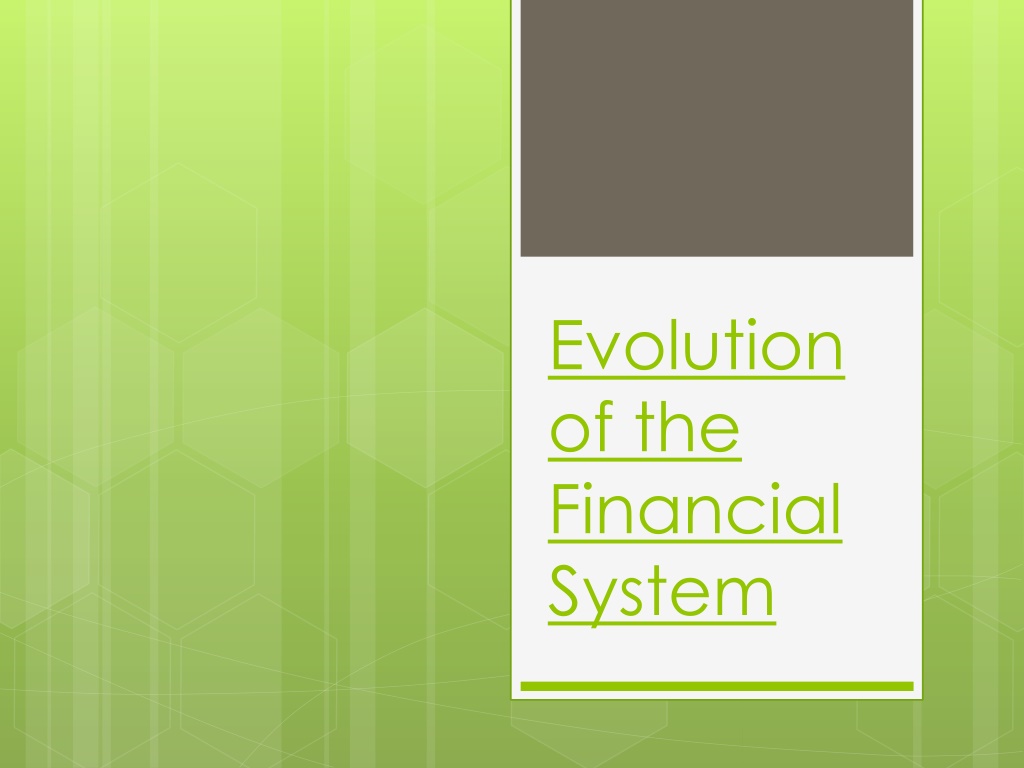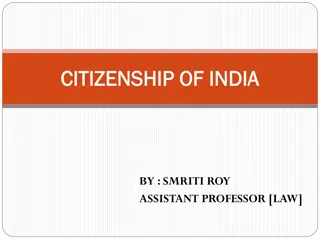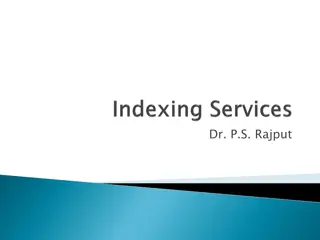Evolution of the Indian Financial System: A Historical Perspective
The Indian Financial System has evolved through distinct phases - Pre-Independence, Post-Independence up to 1991, and post-1991. Pre-Independence saw a closed economy with limited access to foreign savings. Post-Independence witnessed significant growth, nationalization of banks and insurance, development of new institutions, and investor protection measures to restore confidence.
Download Presentation

Please find below an Image/Link to download the presentation.
The content on the website is provided AS IS for your information and personal use only. It may not be sold, licensed, or shared on other websites without obtaining consent from the author. Download presentation by click this link. If you encounter any issues during the download, it is possible that the publisher has removed the file from their server.
E N D
Presentation Transcript
Evolution of the Financial System
The India Financial System falls into 3 different phases : Pre Independence upto 1951 Post Independence 1951 Post 1991
Pre Independence up to 1951 The structure of Indian Financial System during the Pre Independence Era was that of a traditional economy. The main features of the financial system pre 1951 was that of a closed economy consisting of : Semi organised Securities Market. Closed circle Industrial Entrepreneurship Restricted access to foreign savings Absence of financial institutions in long term industrial financing.
Post Independence upto 1990s During the post independence period there has been a significant growth in the Indian Financial System in terms of quantitative indicators as well as in diversification and innovations. This period was the progressive transfer of its important constituents from private ownership to public ownership. An overview of the development of the Indian Financial System in the post independence period up to 1990 s are as under :
1. Nationalization of Banks & Insurance Sector The post 1951 phase was a landmark era in the history of Indian Financial System with the nationalisation of RBI and SBI in 1956 In 1969, 14 major commercial banks were brought under direct control of government of India. The nationalisation of LIC and GIC was yet another historical measure.
2. Development Banks / Institutions In addition to nationalization, the govt created a wide range of new institutions in the public sector. The institutions were created to cater to the financial needs of industries and between them covered the whole range of Industry. The public sector occupied a commanding position in the industrial financing system in India ex ; SIDBI, IFCI, IDBI, UTI etc.
3. Investors Protection During this period, there were gross mismanagement of companies, corporate frauds and abuses which results in loss of public confidence in corporate securities market. To restore investor faith and confidence, the government adopted drastic measures such as : The companies Act, 1956 The Capital Issues Act, 1947 Securities Contracts Act, 1956 Monopolies & Restrictive Trade practices Act, 1970 Foreign Exchange Regulation Act, 1973
Post The New Industrial Policy 1991 The declaration of the New Industrial Policy witnessed a profound transformation in the Indian Financial System. The conservative philosophy of the development process in India shifted to free market economies. The notable developments in the Indian Financial System during this phase are :
1. From Public Control to Private Ownership The major steps initiated during this phase were to privatize important financial institutions. The conversion of the IFCI into a public limited company. IDBI offering their equity to private investors were all the part of privatization of financial institution. The setting up of private mutual funds and banks under the guidelines of RBI also came into existence.
2. Transformation of Institutional Structure The institutional structure if the Indian Financial System has undergone an outstanding transformation. It became more capital market oriented. This reflected in the changes in role, organizational policies, term lending, commercial banks, mutual funds and so on. In August 1991, a high level committee was appointed under the chairmanship of Mr. M. Narsimham (former RBI Governor) to examine all the aspects of the financial system.
The committee submitted its reports in November 1991. the notable reference made were : Privatization of Financial Institutions. Re-organisation of existing financial structure. Protection of Investors. Adequacy of Capital Structure. Review of Supervisory Arrangement. Improve Efficiency, Effectiveness and Competitiveness.
Weaknesses of Indian Financial System
1. Govt Interference The Indian Financial System is all time politicised by excessive government intervention. The political intervention has its source in state ownership. This leads to virtual lack of freedom for the banks, financial institutions, financial markets etc. to enhance productivity and efficiency, greater degree of autonomy should be ensured.
2. Lack of Professionalism One of the drawback of Indian Financial System has been caused due to unprofessional management. Absence of work culture, inadequate internal controls, insufficient delegation of authority have caused competitive inefficiency. Professional oriented management is very good for performance.
3. Lack of Direction The effectiveness of the financial system lies in rendering efficient and timely services limited delegation of authority, excessive regulation by govt and stringent controls have given rise to lack of direction in Indian Financial System.
4. Lack of Operational flexibility It is said that the functional autonomy is a pre requisite for operational flexibility of financial system to achieve improved performance in terms of productivity, efficiency and profitability. Due to tight regulation and strict controls by govt, there is lack of operational flexibility in Indian Financial System.
5. Excessive Regulation One of the issues in the Indian Financial System is that of over regulation. If every aspect of the system is subject to control and approval, then the financial system loses its innovative character which obstructs the growth. Though Indian Financial System has adopted liberal reforms since 1991, still there are scopes to adopt the same in other spheres.
6. Lack of Coordination There are large numbers of participants in the Indian Financial System. It is characterized pre dominantly by the public sector institution, which at times give rise to the problem of coordination in the working of these institutions.
7. Lack of Transparency The banks and financial institutions adopt certain accounting practices which do not show realistic picture. There is lack of transparency in such disclosures. It raises the problem of integrity with regard to the Indian Financial System and hampers the financial health of the economy. The banks make themselves more transparent and accountable in order to gain investor confidence.

























